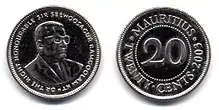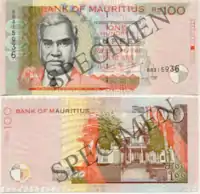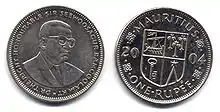Mauritian rupee
The Mauritian rupee (sign: ₨; code: MUR; pronounced [ʁupi]) is the currency of Mauritius. One rupee is subdivided into 100 cents. Several other currencies are also called rupee.
| Mauritian rupee | |||||
|---|---|---|---|---|---|
| Roupie mauricienne (French) Rupi morisien (Morisien) மொரீசியஸ் ரூபாய் (Tamil) मॉरिशियाई रुपया (Bhojpuri-Hindi) | |||||
| |||||
| ISO 4217 | |||||
| Code | MUR | ||||
| Denominations | |||||
| Subunit | |||||
| 1/100 | cent | ||||
| Symbol | ₨[1] | ||||
| cent | ¢ or MU¢ | ||||
| Banknotes | ₨ 25, ₨ 50, ₨ 100, ₨ 200, ₨ 500, ₨ 1000, ₨ 2000 | ||||
| Coins | 5¢, 20¢, 50¢, ₨ 1, ₨ 5, ₨ 10, ₨ 20 | ||||
| Demographics | |||||
| User(s) | |||||
| Issuance | |||||
| Central bank | Bank of Mauritius | ||||
| Website | www | ||||
| Valuation | |||||
| Inflation | 3.6% | ||||
| Source | Bank in Mauritius, April 2013 est. | ||||
Coins
In 1877, coins for 1, 2, 5, 10 and 20 cents were introduced, with the lower three denominations in copper and the higher two in silver. Coin production ceased in 1899 and did not recommence until 1911, with silver coins not produced again until 1934, when ¼-, ½- and 1-rupee coins were introduced. In 1947, cupro-nickel 10 cents were introduced, with cupro-nickel replacing silver in 1950.1000

In 1971 a new set of coins and banknotes were introduced by the Royal Mint. This set has Queen Elizabeth II on the obverse and a range of heraldic motives on the reverse. Some of the reverse designs for this set were designed by Christopher Ironside OBE including the 10-rupee, 200-gold-rupee and 250-gold-rupee (issued 1988).
In 1987, a new series of coins was introduced which, for the first time, did not feature the portrait of the monarch (Mauritius did not become a republic until 1992) but that of Sir Seewoosagur Ramgoolam. This coinage consisted of copper-plated-steel 1 and 5 cents (the 5 cents was substantially reduced in size), nickel-plated-steel 20 cents and ½ rupee, and cupro-nickel 1 and 5 rupees. Cupro-nickel 10 rupees were introduced in 1997. Coins currently in circulation are the 5 cents, 20 cents, ½ rupee, 1, 5, 10 and 20 rupees. Coins below 1 rupee in value are generally regarded as "supermarket" small-change. The 1 cent coin has not been seen in circulation for many years, and the last series of 1 cent coins issued in 1987 are only seen as collectors' items.
In 2007, a bi-metallic 20-rupee coin was issued to commemorate the 40th anniversary of the Bank of Mauritius, and this has now become a coin in general circulation.
| Current Mauritian rupee coins | |||||||
|---|---|---|---|---|---|---|---|
| Image | Value | Composition | Diameter | Weight | Thickness | Edge | Issued |
| 1 cent | Copper-plated steel | 17.8 mm | 2 g | 1.27 mm | Smooth | 1987 | |
| 5 cents | Copper-plated steel | 20 mm | 3 g | 1.5 mm | Smooth | 1987-2017 | |
| 20 cents | Nickel-plated steel | 19 mm | 3 g | 1.65 mm | Reeded | 1987-2016 | |
| 50 cents | Nickel-plated steel | 23.6 mm | 5.83 g | 2 mm | Reeded | 1987-2016 | |
| 1 rupee | Copper-nickel | 26.5 mm | 7.45 g | 1.8 mm | Reeded | 1987-2010 | |
| 1 rupee | Nickel-plated steel | 26.6 mm | 7.5 g | 2.2 mm | Reeded | 2012-2016 | |
| 5 rupees | Copper-nickel | 31 mm | 12.62 g | 2.36 mm | Security | 1987-2010 | |
| 5 rupees | Nickel-plated steel | 31 mm | 12.55 g | 2.8 mm | Security | 2012-2018 | |
| 10 rupees | Copper-nickel | 27.5 mm (heptagonal) | 5.83 g | 2.2 mm | Smooth | 1997-2000 | |
| 10 rupees | Nickel-plated steel | 28 mm (heptagonal) | 8.5 g | 2 mm | Smooth | 1987-2016 | |
| 20 rupees | Bi-metallic; copper-nickel center in nickel-brass ring | 28 mm | 10 g | Reeded | 2007 | ||
Banknotes
The first banknotes were issued by the government dated 1876 in denominations of 5, 10 and 50 rupees. 1-rupee banknotes were added in 1919. In 1940, emergency issues were made of 25 and 50 cents and 1 rupee. In 1954, 25 and 1000 rupees were introduced.
The Bank of Mauritius was established in September 1967 as the nation's central bank and has been responsible for the issue of banknotes and coins since that time.[2] The bank issued its first notes in 1967, comprising four denominations: 5, 10, 25, and 50 rupees, all undated and featuring a portrait of Queen Elizabeth II on the obverse. Over the years, some denominations were revised with new signatures of the Bank's Governor and Managing Director but were otherwise unchanged.
| 1967 "Elizabeth II" Issue | |||
|---|---|---|---|
| Image | Denomination | Obverse | Reverse |
| 5 rupees | Queen Elizabeth II | Monument marking the landing of the Dutch at the bay of Grand Port (1598), sailing boat | |
| 10 rupees | Government House, Port Louis | ||
| 25 rupees | Bullock cart | ||
| 50 rupees | Port Louis Harbour | ||
In 1985, the Bank of Mauritius issued a completely new set of banknotes of 5, 10, 20, 50, 100, 200, 500 and 1000 rupees. A close study of these banknotes reveals an interesting array of subsets which were printed by two banknote printing companies (Bradbury Wilkinson and Thomas de La Rue). The banknotes were also designed at different time periods as there are very few identical and consistent design features appearing on all the denominations. Varying banknote numbering systems, different types of security threads, variations in the design and size of the Mauritian Coat of Arms, different ultraviolet light latent printing, inconsistent variations in the size incrementation between the denominations and multiple different typesets are just a few of the differences. This issue lasted up to 1998.
In 1998, The Bank of Mauritius made a new issue of banknotes consisting of 7 denominations, viz. 25, 50, 100, 200, 500, 1,000 and 2,000 rupees. These banknotes had a standard format and were all issued simultaneously in November 1998. All the banknotes of this issue were printed in England by Thomas de la Rue Limited. These first banknotes were withdrawn from circulation in June 1999 following controversies due to the ordering of the text (English, Sanskrit, Tamil) while the population of Mauritius was mostly Tamil.
The Bank of Mauritius made its latest issue of banknotes, which is still current, after June 1999.
Obverse designs
Each denomination bears a hand engraved portrait of a prominent Mauritian figure, which appears on the left.
| Denomination | Portrait | Vignette |
|---|---|---|
| 25 rupees | Moilin Jean Ah-Chuen | Rodrigues |
| 50 rupees | Joseph Maurice Paturau | Le Caudan |
| 100 rupees | Renganaden Seeneevassen | Court House |
| 200 rupees | Sir Abdool Razack Mohamed | Mauritian Market |
| 500 rupees | Sookdeo Bissoondoyal | University of Mauritius |
| 1000 rupees | Sir Charles Gaëtan Duval | State House |
| 2000 rupees | Sir Seewoosagur Ramgoolam | Bull & Sugarcane Cart |
The top of the bill says "Bank of Mauritius". The portrait is toward the center-left of the bill and below the portrait is the name of the person in the portrait and their year of birth to year of death. On the bottom-left is the coat of arms of Mauritius. There is also a drawing of the Bank of Mauritius building and a portrayal of the statue of justice in the background of each of the denominations in the center of the bill. The value of the bill is in the top-right corner with the "₨" symbol in front the value. Below the value in the top-right corner is a feature to aid the visually impaired. This is in addition to the differences in sizes between the banknotes of various denominations. The left side of the note says the numerical value of the note, with the "₨" symbol to the left of the value, written sideways left-faced up. On top of the numerical value on the left side is the serial number of the bill. The serial number is also on the center-right of the bill. On the top-center of the bill is states "This Note Is Legal Tender For", then it states the bill's value written out in English (ex: "One Hundred"), and below that it says "Rupees". Below that it says the value of the bill in Tamil, and below that it says the value of the bill in Bhojpuri-Hindi. Below that is the signature of the Governor of the Bank of Mauritius and next to that is the signature of the Managing Director, or it could have the signatures of the First Deputy Governor, then the Governor, then the Second Deputy Governor. Below that is the year the bill was printed.
Reverse Designs
The top left of the note on the reverse says "Bank of Mauritius". The left side of the note says the numerical value of the note, with the "₨" symbol to the left of the value, written sideways left-faced up. The top right of the note has the numerical value of the note with the "₨" symbol to the left of the value. Each denomination carries a different vignette, depicting various aspects of Mauritius. The Bhojpuri-Hindi value of the note can be found on the left side of the bottom of the vignette, with the Bhojpuri-Hindi abbreviation of rupee, "रु" ("ru") in front of the value. The Tamil and Gujarati numerical value of the note can be found on the right side of the bottom of the vignette. The Tamil value is above the Gujarati value.[3]
Features for authenticity verification
- The feel of banknotes paper
- Three-dimensional watermark in the form of a dodo: When held up to the light the head of the dodo can be clearly viewed.
- See-through in the form of a conch shell: this image completes when viewed against direct light.
- Windowed security thread reading "Bank of Mauritius" when held up to the light, this can be seen as a continuous band running through the paper. Viewed flat, the metallic areas can be seen on the surface of the paper.
- Engraved Portrait in Intaglio ink.
- Latent image: when viewed at eye level, the image of "BM" becomes visible.
- Micro-text reading "BM": under a magnifying glass, these letters are clear to see.
- Under ultra-violet light: figures corresponding to the face value of the banknote become apparent.
100-, 200-, 500-, 1000-, 2000-rupee banknotes
Iridescent band in gold: when held under the light, this band visualizes and disappears when the viewing angle is changed.
100-, 200-rupee banknotes
Silver metallic ink: dull silver metallic band running from top to bottom on front, left of note. Metallic strip also beneath top right value numeral.
500-, 1000-rupee banknotes
Silver Foil: two different images, value numeral or geometric shape, can be seen when viewed from different angles.
2000-rupee banknote
Hologram containing images of the dodo and the value "2000"
200-, 500-, 1000-rupee banknotes
Hologram containing images of the dodo and the denomination on the 200-rupee banknote, a deer and the denomination on the 500-rupee banknote and the Bank of Mauritius tower and the denomination on the 1000-rupee banknote.[4]
25-, 50-, 500-rupee banknotes
Revised security features and the change of material from paper to polymer.[5][6]
2000-rupee banknote Revised security features and the change of material from paper to polymer.[7]
Commemorative coins
| Value | Composition and finish | Mass | Diameter | Issue date | Commemorative subject |
|---|---|---|---|---|---|
| Rs 25 | Silver non-proof | 38.61 g | 38.61 mm | April 1978 | 10th anniversary of the independence of Mauritius |
| Rs 20 | Silver proof | 28.28 g | 38.61 mm | May 1998 | 50th anniversary of the wedding of Queen Elizabeth II and Prince Philip |
| Rs 1000 | Gold proof | 17 g | 31.00 mm | January 2000 | 150th anniversary of the setting up of the Mauritius Chamber of Commerce & Industry |
| Rs 10 | Silver proof | 28.28 g | 38.60 mm | January 2000 | 150th anniversary of the setting up of the Mauritius Chamber of Commerce & Industry |
| Rs 100 | Silver proof | 36.76 g | 44 mm | November 2001 | Centenary of the arrival of Mahatma Gandhi in Mauritius |
| Current MUR exchange rates | |
|---|---|
| From Google Finance: | AUD CAD CHF EUR GBP HKD JPY USD |
| From Yahoo! Finance: | AUD CAD CHF EUR GBP HKD JPY USD |
| From XE.com: | AUD CAD CHF EUR GBP HKD JPY USD |
| From OANDA: | AUD CAD CHF EUR GBP HKD JPY USD |
| From fxtop.com: | AUD CAD CHF EUR GBP HKD JPY USD |
References
- Bank of Mauritius Archived 2006-12-28 at the Wayback Machine.
- Linzmayer, Owen (2012). "Mauritius". The Banknote Book. San Francisco, CA: www.BanknoteNews.com.
- http://www.crnindia.com/currency/mauritian_rupee.html
- Mauritius new 200-, 500-, and 1,000-rupee banknotes confirmed BanknoteNews.com. December 15, 2011. Retrieved on 2015-02-13.
- Mauritius new 500-rupee polymer notes confirmed BanknoteNews.com. September 29, 2013. Retrieved on 2015-02-13.
- Mauritius new 25- and 50-rupee polymer notes confirmed BanknoteNews.com. September 21, 2013. Retrieved on 2015-02-13.
- Mauritius new 2,000-rupee polymer note (B436a) confirmed Banknote News (banknotenews.com). December 14, 2018. Retrieved on 2019-01-20.
External links
| Preceded by: Indian rupee, British pound, Mauritian dollar Ratio: both rupees = 0.5 dollar or 10¼ rupee = 1 pound |
Currency of Mauritius 1877 – |
Succeeded by: Current |
| Currency of Seychelles 1877 – 1914 |
Succeeded by: Seychellois rupee Reason: became a separate crown colony in 1903 Ratio: at par |


.svg.png.webp)